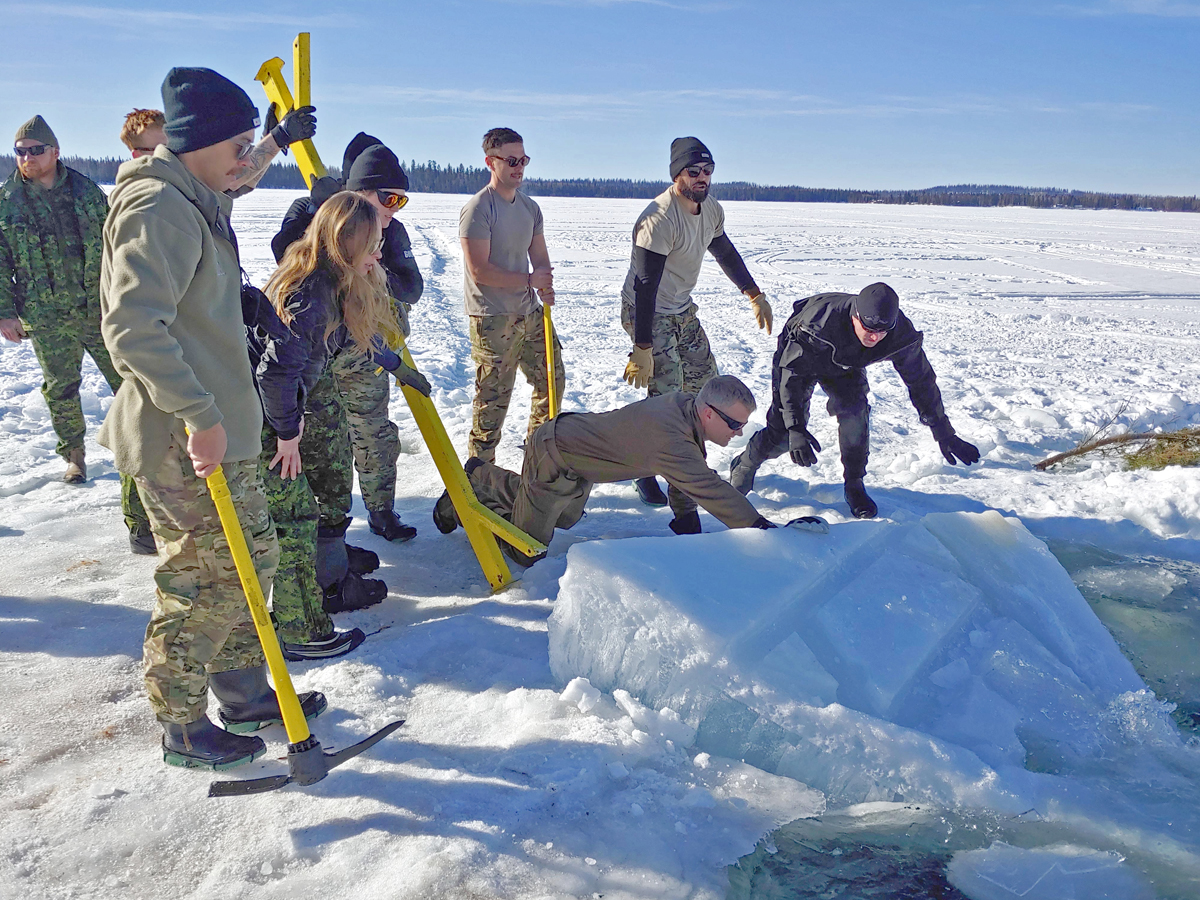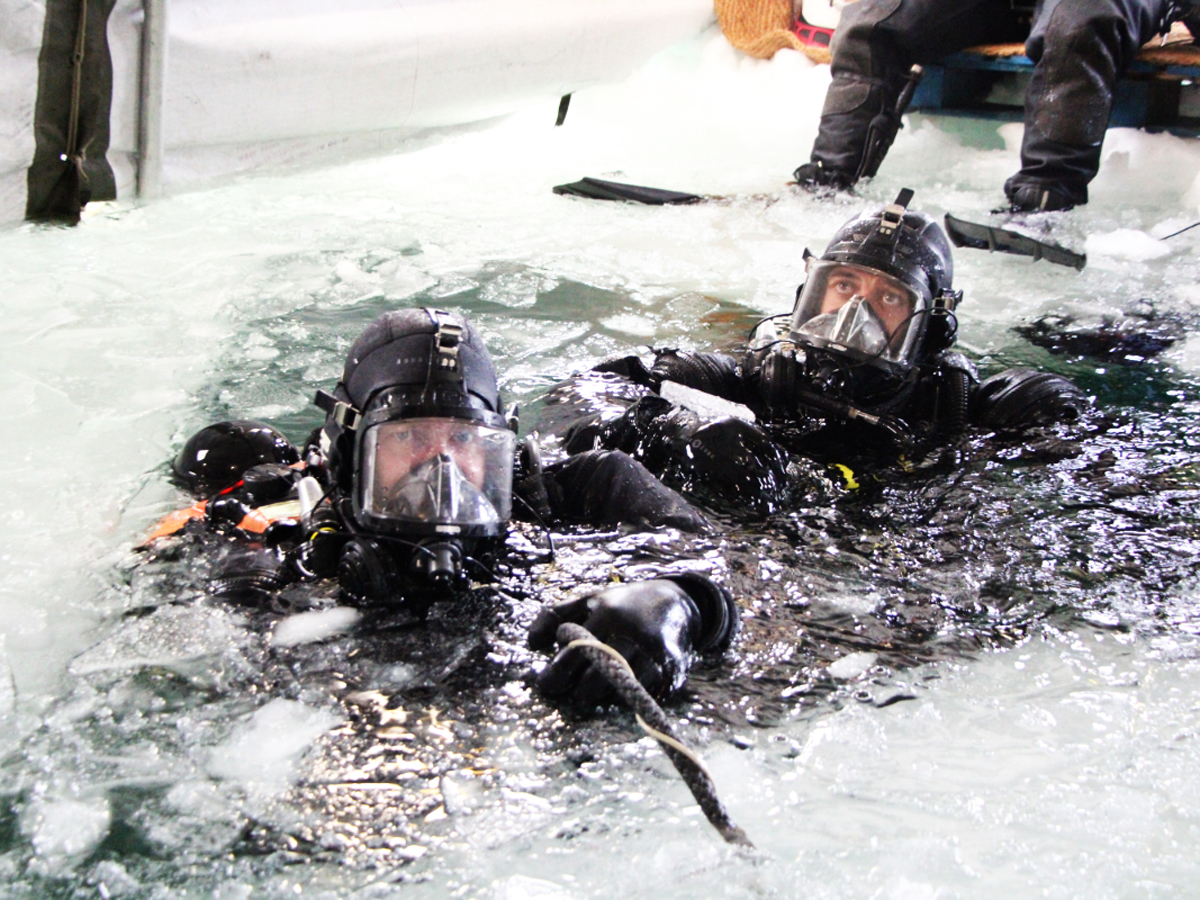FDU leads ‘Ice-cold’ international diving “EX”
By Lookout Production on Mar 27, 2023 with Comments 0

Participants cut a hole in the ice at Sheridan Lake before setting up their shelters at ICEDIVEX23 a five-day training exercise led by Fleet Diving Unit (Pacific). An international team of 39 divers arrived at the lake to challenge their extreme cold-weather diving skills.
Peter Mallett
Staff Writer
—
Using snowmobiles and military toboggans, they towed their equipment onto an ice-covered lake in B.C.’s southern interior.
After carving out holes in the ice, the divers slipped below the surface.
The team of 39 divers from Canada and four other nations arrived at Lake Sheridan on March 6 to challenge their extreme cold-weather diving skills. The training was part of ICEDIVEX 23, a five-day training exercise led by the Fleet Diving Unit (Pacific) (FDU(P)).
Lieutenant (Navy) Demetris Mousouliotis, Operations Officer of FDU(P) and the exercise’s team leader, said the exercise helped maintain operational diving expertise in extreme cold weather and under-ice environments.
“Adapting to the unforgiving conditions was the most challenging aspect of the exercise,” Lt(N) Mousouliotis said.
The diving exercise was conducted below a 40-cm-deep layer of ice that covered Lake Sheridan, located approximately 40 km southeast of 100 Mile House. The divers conducted their training about 11 meters below the surface.
The divers deployed in teams of two, with a third ‘Standby Diver’ remaining on the surface, ready to respond in an emergency.
The team conducted three tasks:
Task one was to search, locate and recover a dead body, represented by an OSCAR Dummy, typically used for training by water-rescue personnel;
Task two was to search, find, identify and retrieve a fictitious air-dropped explosive device;
Task three involved a puzzle box suspended under the surface of the ice that divers had to try and solve while maintaining buoyancy within their water column.
To enhance the team member’s safety, the divers also practiced a rescue procedure drill involving the Standby Diver and a ‘Lost Diver’. The Lost Diver anchored themselves to the underside of the ice while the Standby Diver located and rescued them.
Lt(N) Mousouliotis said the diving conditions were excellent, despite the chilly water temperatures that hovered just above the freezing point.

Two members of the ICEDIVEX23 team return to the surface of Sheridan Lake after a dive. Photo: Patrick Davies,100 Mile Free Press
“Overall, ICEDIVEX23 was a success,” Lt(N) Mousouliotis said, adding their success was enhanced by the 4th Ranger Patrol Group’s positive attitude and eagerness to help.
Outside ice diving, the FDU(P) and the United States Navy divers visited Peter Skene Ogden Secondary School in 100 Mile House for an outreach mission. They set up multiple displays in the main foyer. They spoke about Royal Canadian Navy programs such as the Raven Indigenous Youth Employment Program, Canadian Students at Sea program, RCN’s Naval Experience Program, and the Canadian Leaders at Sea program. The divers also helped serve lunches and played sports against the students.
The international diving team consisted of the following:
15 Clearance Divers of FDU(P);
12 divers of the United States Navy Mobile Diving and Salvage Unit One;
5 from the Royal New Zealand Navy;
2 observers from the Royal Netherlands Navy; and
4 from the Royal Navy.
The main focus for divers from visitor nations were learning what it takes to conduct ice diving and if it’s something they can facilitate back home. The divers were housed at Sheridan Lake Resort for their stay.
Gear:
Cold-weather clothing and diving gear;
Snow sleds;
Trailers;
Augers;
Chain saws;
Snow blowers;
First aid kits; and
An ice-lifting device.
The divers relied on Ultra-Light Weight Surface Supplied Dive System (ULWSSDS).
The ULWSSDS includes a 90-meter-long tether which is their lifeline to the surface and is connected to SCUBA tanks and communications equipment.
Filed Under: Top Stories
About the Author:






